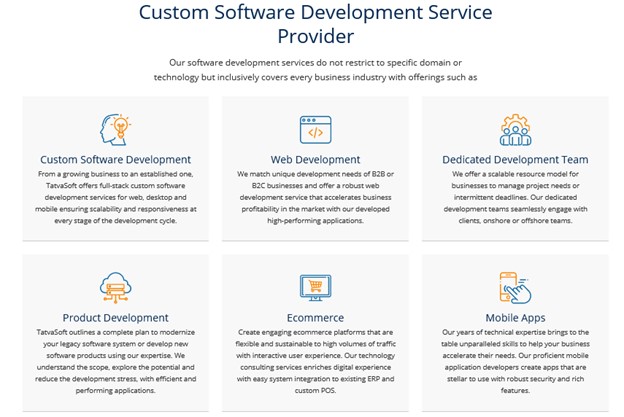How To Mould A Software Development Team Structure To Yield The Best Performance?
The worldwide information technology industry is accelerating its growth. Businesses respond to the explosive growth of the information technology market by developing software for both consumer and internal use.
However, due to this increased interest in software development, many executives lack the knowledge necessary to successfully oversee a software development project.
One of the most difficult difficulties facing CEOs is determining how to design custom software while retaining the capacity to adapt to changing market conditions quickly. Some organizations continue to hire traditional personnel on a full-time basis, using Automated software testing tools such as TestRigor.
In contrast, others outsource software development services such as eCommerce, product development, UI/UX designing, enterprise solutions, and so forth.
So if you’re looking for the business benefits such as cost-effective mechanisms, data collection and evaluation, reduced human error, increased marketing, engagement, sales, and so forth, it would surely add up to your knowledge of how software development plays a crucial role for business growth.
However, if we look at some facts, Information Technology was on track to generate $3.8 trillion in annual revenue by the end of 2019. By the year 2021, it has generated maybe even more. A large portion of this growth is attributed to software development, which produces an estimated $481 billion in annual revenue.
Additionally, managers struggle to pick the appropriate software development technique and test their products for security flaws and end-user satisfaction. When tech firms anticipate their following major product, they frequently envision a self-managed technical workforce wholly committed to their task.
In reality, assembling a great development team is not always as straightforward. What distinguishes a good software developer from a great one is team members’ trust in reaching shared objectives.
Indeed, most development projects fail prematurely due to a collective and individual lack of faith in the project’s success. As many as 78% of information technology experts report feeling overwhelmed with project needs.
This article will assist executives in establishing an effective software development team capable of delivering high-quality products that contribute to their business’s growth.
In this article, you’ll learn tried-and-true strategies and best practices for assembling a successful software development team, from recruiting the proper personnel to project management procedures. Keep an eye out!
What Is A Software Development Team?

Teams of software developers collaborate to create a technical project or product. Each development team member contributes to this effort and should be held accountable for their actions. Above all, software development teams should be self-organizing and cross-functional. Individually structured and efficient labor maximizes the development team’s total effectiveness.
Simultaneously, team members must work cooperatively to communicate and carry out shared obligations. To create this synergy between team structure and empowerment, development teams must bear the following features in mind:
- The team is naturally self-organizing, and productivity is contingent on group effort.
- The teams are well-equipped and cross-functional; they possess all of the team abilities required to advance the product through all stages of development.
While individual development team members may have specific talents and domains of concentration, the software development team bears accountability. Successful software engineering teams have people who:
- Leave the codebase in a better state than when it was discovered;
- Recognize and share their customer’s interests;
- Rather than condemning individuals directly, they critique their ideas;
- Share your past and current experiences to provide new team insights;
- Have fun together and trust one another.
How Can Project Managers Determine The Success Of A Development Project?
Having the proper framework in place for your development team is critical. It can be challenging to solve, but it is worth the time and effort to increase production and efficiency.
The team structure is critical to the project’s success and elicits peak performance from your development team and keeps them focused on the goal. Here are five recommendations to assist you in determining the optimum structure for your development team to maximize the value of your project.
Have A Plan
With adequate planning, everyone understands their specific responsibilities throughout the project. Therefore, before you begin, develop a project strategy and methodology to guide you to success. Take the time to become familiar with the development tools you’ll utilize and the technical design that will support your product.
A Software Development Team Structure – Ascertain that you have the following:
- Plans with unambiguous aims;
- Outline of the application;
- Code audits;
- Automated testing;
- Tracking of bugs and tasks.
Hire The Right Kind Of Development Team Member That Fits Your Project
Hiring is never a simple process. And hiring a software development team remotely just on their CVs and a few Zoom interviews is much more difficult. Nonetheless, some characteristics highlight a candidate’s ability to contribute to a great software development team.
What should you look for in a software developer?
- Influential software developers work in teams;
- The era of software developers who write high-quality code has passed us by. Particularly in software development, it is critical to have talented engineers who are also excellent communicators;
- The success of your future product is contingent upon effective communication and teamwork. Consider candidates who are willing to discuss their experience attaining a goal as a team, resolving contentious ideas, and appreciating the unique contributions of their colleagues.
Consider hiring software developers who create excellent software and strive to accomplish tasks and achieve as a team rather than simply collecting points for their crown.
Other Benefits: They Take an Active role
The software developers you’re looking for won’t sit around waiting to be assigned a task. They’ll want to work for your organization not just for the salary but also for the opportunity to work on an intriguing and challenging project. This is where motivation enters the picture.
They’ll ask questions, suggest the best way to organize sprints, and so on. And even if their ideas aren’t always brilliant, they’ll stimulate other team members’ thinking. And these are the developers you should recruit for your software development team.
They accept accountability
I’m guessing that response is the most frequently encountered soft skill on CVs. And while determining if a candidate is truly accountable is nearly impossible, you should attempt. Inquire about their daily schedules, task prioritization, report writing, and handling unscheduled patches, alignment meetings, or rollbacks.
They are constantly looking for ways to push the boundaries of their comfort zone
The ideal members of an excellent developer team (and those you absolutely must discover) exhibit fundamental self-learning attitudes and pleasure in acquiring new skills. They are comfortable taking on new jobs that require them to step outside their comfort zone.
Inquire what they would do if they were offered the opportunity to temporarily assume a colleague’s tasks in X field and observe how easy they would agree. Keep an eye out for people asserting that they will not perform a task unless included on their duty list. You’ll end up with unending disagreements over who does what and for how much.
Define Team Roles And Responsibilities
Not every member of a successful software development team is a coder. Other team members contribute significantly to the effectiveness of the work process. Although the team’s composition varies according to the circumstances, the following is the most common example.
While the software development team has a common vision, objective, and overall aim, each engineer knows their own roles and responsibilities.
Areas of responsibility and roles within the team are defined from the project’s outset based on the common aim; this ensures that each team member understands what they must perform. This avoids micromanagement and increases team transparency. We shall return to this subject in greater detail in the subsequent sections of the article.
- A Product Owner is someone who has a vision for the ultimate product. PO is responsible for meeting the needs of stakeholders, sponsors, and end-users, among others. This function is typically filled by a representative of the client who interfaces with the development team, or in rare situations, by the customer himself.
- The project manager is accountable for the project’s successful commencement, planning, scope definition, implementation, monitoring, and closure. The PM optimizes the team’s work, establishes goals, and ensures that the result satisfies all requirements.
- Scrum Master (if required) is a Scrum methodology role. This individual is accountable for the entire team adhering to the most appropriate Scrum practices. SM aids team members in comprehending the framework’s theory, values, and regulations. Additionally, which Scrum contacts are beneficial and which are not in given circumstances.
- The Software Architect makes critical design decisions about the software system’s internal structure and technical interfaces. It is a highly trained software developer capable of defining the technology stack and reviewing the code to guarantee the design is of high quality: SA mentors and assists developers along the process.
- Developers of software. This is the location of all the magic. These are team members who contribute their coding expertise to the development of software.
- UI/UX designers are experts in designing interfaces and offering the best possible digital user experience.
- The business analyst studies the client’s business needs and looks for ways to improve the quality of digital products and services.
A Software Development Team Structure: Use Project Management Software
Automate repetitive tasks using project management software. Routine tasks follow a predefined sequence of actions until they are completed. For instance, a developer initiates a process for code modifications and performs the following step: submits the modified code for peer review using the project management tool. Their team member approves it and then moves on to the last step: transferring modified code to quality assurance specialists.
Additionally, this type of software visualizes the entire development process. Each team member may see how their work relates to the work of others. As a result, they perceive their contribution to the project’s progress, which increases the team’s sense of ownership and maturity and aids in deadline compliance. Consider using the following tools: Wrike, Nintex, Teamwork Projects, Backlog, and Monday.com.
Evaluate And Cultivate Soft Skills
Believe it or not, soft skills typically define the success of your software development team rather than technical skills. A well-developed project necessitates more than just programming; it necessitates a receptive and communicative team.
You should seek soft skills and cultural fit during the hiring process. Emotional intelligence is critical to the success of any collaborative enterprise. Genuine cohesion is founded on a foundation of relatability and communication.
Encourage collaboration between silos. Cross-functional project teams have become more vital for firms seeking to differentiate themselves and remain competitive – particularly in the technology sector.
Recruiters frequently seek people who excel at collaborative work. Additionally, they need individuals who are not hesitant to offer a second perspective or shake up project teams. Prioritize social and communication skills. When managing a software development team, it’s all too tempting to focus exclusively on technical output at the expense of team building and communication.
Make it a priority for your staff to understand that empathy and emotional intelligence are just as important as doing high-quality work. To accomplish this, you should:
- Establish peer-to-peer learning and teaching opportunities
- Recognize the team’s many personality types and develop an understanding of how to work with their strengths and flaws
- Make dialogue a priority!
Build An Agile Software Development Team And Use Agile Methodology
Only a great tech-savvy know the agile principles and can deliver a professional agile development process and an outstanding team structure based on nearly a decade of bringing the most advanced technology solutions to the corporate world. As a result of this framework, each software application developed by a tech-savvy person comprises meticulous preparation and coordination among the project’s team members.
What is Scrum? The Agile Software Development Methodology is the most often used in IT firms, and Scrum is a framework that is frequently used in conjunction with it. Scrum is defined by well-planned sprints that are constantly reviewed and adjusted as they progress.
The Workflow
After thoroughly analyzing user needs, UI/UX Designers would demonstrate design concepts through process flows, storyboards, and sitemaps, and create graphical user interface elements like menus, tabs, and widgets.
According to the UI/UX concept, developers will utilize an appropriate programming language/required technologies to build clean, efficient code following standards. Team members must work well together to develop and implement optimal functional programs.
There are three types of developers in this phase:
- Web designers
- Developers of mobile applications
- DevOps
Web application developers are responsible for building and designing web/network applications and ensuring they function correctly on the internet. Because a site comprises both an interface – what users see – and code – which only developers see – it is often divided into Front-end and Back-end developers.
- Front-end developers are responsible for everything that consumers see initially in their browser or application; in other words, they are in charge of the user’s perception.
- Back-end developers charge an application’s server-side logic and all communication between the database and the browser.
Mobile application developers include teams of iOS and Android developers and cross-platform developers capable of developing programs that run on both iOS and Android systems.
DevOps is another critical component of a software developer’s job. They are made up of members of the Development and Operations teams. The primary purpose of DevOps is to improve the product’s quality significantly and boost communication between the development and operations teams, resulting in a smoother workflow within the business.
Finally, Quality Assurance (QA) is depicted at the diagram’s bottom level. After obtaining the initial version of the product, the QA department will conduct testing to see whether the draught contains any flaws.
They translate requirements and documents into a collection of test cases and scripts that may be used to determine whether the application satisfies the client’s expectations. These test cases will be repeated indefinitely until no unexplained fault is discovered in the system.
Make Communication A Priority 
Finally, but certainly not least, communication. This is the final piece of the jigsaw, and it is frequently the difference between success and failure for a software development team.
You can have all the other parts in place and running effectively. Still, if your team is missing this final component, it can significantly negatively impact your product and the entire process.
Regardless of how hard your staff works daily, they spend adequate time communicating with one another. It’s beneficial when discussing the intricacies and requirements of the project with stakeholders, negotiating timetables, and generally attempting to understand what the stakeholders desire.
Additionally, if your team members can effectively communicate their wants and project requirements, they can increase their collaboration and the overall work process. Additionally, it is capable of fostering creativity and innovation among the team.
Excellent communication skills are critical for any software engineer. However, it would help if you took their communication ability for granted. Your job is to foster and facilitate communication within your software development team and integrate it into your everyday operations through daily standups, design and code reviews, documentation, presentations, and certain social events.
Evaluate Team’s Performance
You’ve mastered the art of developing a development team at this stage. Assume your team is performing well, and now it’s time to determine how excellent and effective it truly is. Any team performance evaluation should place a premium on two factors: team outcomes and team process.
The team’s primary objectives establish the team’s outcomes. It could be anything from improved product quality faster delivery times, and resource conservation. On the other hand, team process refers to how the team accomplishes its goals – how well team members resolve issues, communicate information, manage budgets, schedules, and interpersonal relationships.
Observing how well your team functions and evaluation enables you to establish benchmarks for future reference. However, examining all team processes becomes even more vital when a team encounters internal roadblocks.
Several techniques evaluate your team’s processes; however, benchmarking ongoing team conversations and project debriefings is the most straightforward and effective.
As you can see, assembling a software development team is similar to making a baseball team. Everyone has and understands their function, their location on the field, and the same goal.
It is not sufficient to select competent specialists; they must fit together like puzzle pieces. And it is your responsibility to get to know each applicant thoroughly to determine how well they function together.
Learn to value teamwork and celebrate tiny victories along the path to achieving the ultimate objective. Establish a specific development team that is capable of success in this constellation.
Better yet, construct a team that will want to collaborate even after your project is over – this will be a true indication that you did not just create a competent outsourced development team but a terrific one.
Software development team structure: final thoughts
Efficient development teams necessitate effective communication, as this characteristic enhances the team’s strengths and mitigates its flaws. The team should have a strong sense of direction, ownership of the task, and buy-in to the process.
Teams require a high-quality work environment, as team outcomes will likely reflect, rather than fix, the environment. While a hybrid team structure is preferable, the team structure must ultimately meet the persons available and the project’s requirements.
While the adage “a team is only as good as its weakest link” may be exaggerated, the most effective teams undoubtedly comprise individuals who understand their jobs, excel at them, and collaborate.




















